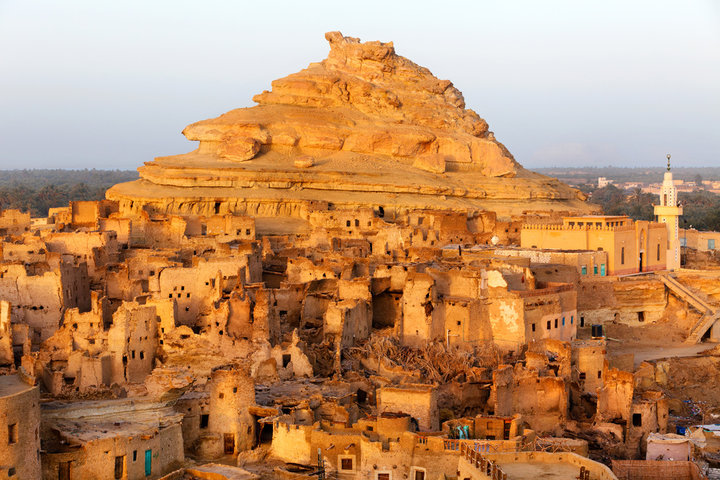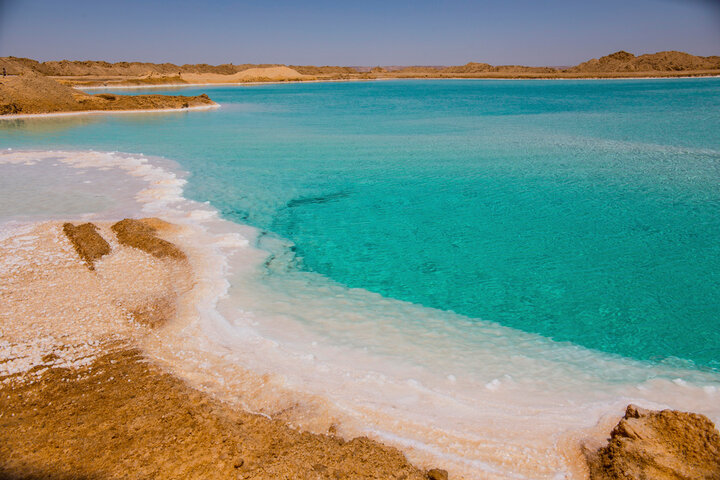Siwa Oasis, located deep in Egypt’s Western Desert near the Libyan border, is one of the most isolated and historically rich oases in the country. Known for its stunning natural beauty, unique culture, and significant historical sites, Siwa offers a tranquil retreat from the hustle and bustle of more popular tourist destinations. The oasis is home to a small population of Berbers, who have preserved their distinct language, traditions, and way of life over centuries.
With a history dating back to ancient times, Siwa has been a site of continuous human settlement for thousands of years. It played a significant role in ancient Egyptian and Greco-Roman history, particularly due to the famous Oracle of Amun. Today, Siwa is celebrated not only for its historical significance but also for its breathtaking landscapes, which include vast date palm groves, salt lakes, and hot springs, all set against the backdrop of the stark Sahara Desert.
Siwa’s history stretches back to the dawn of human civilization. The oasis has been inhabited since at least the 10th millennium BCE, with archaeological evidence suggesting that it was an important center of early human activity. Siwa became known in ancient times as a center of worship for the god Amun, one of the most powerful deities in the Egyptian pantheon.
The most significant period in Siwa’s history came during the 26th Dynasty (664–525 BCE), when the Oracle of Amun gained fame across the Mediterranean world. This oracle, located in the Temple of the Oracle, was sought out by many, including the famous conqueror Alexander the Great, who visited Siwa in 331 BCE to seek the oracle’s blessing before continuing his campaign to conquer Persia. According to legend, the oracle confirmed Alexander as the legitimate pharaoh of Egypt and the son of Amun, further solidifying his divine status.
Throughout the Greco-Roman period and into the Islamic era, Siwa remained relatively isolated, allowing its unique culture and traditions to flourish relatively undisturbed. The oasis was often referred to as “the oasis of Jupiter-Amun” during the Roman period, reflecting its continued religious significance.
In more recent history, Siwa has become a focal point for tourism, drawing visitors with its rich history, stunning landscapes, and unique cultural heritage. The oasis remains one of Egypt’s most enigmatic and picturesque destinations.




Siwa Oasis offers a diverse range of attractions that combine its ancient history with its natural beauty. Here are the top 10 must-visit sites in Siwa Oasis, each offering a unique experience that showcases the oasis’s rich cultural heritage and stunning landscapes.
Description: The Temple of the Oracle, also known as the Temple of Amun, is perhaps the most famous site in Siwa Oasis. This ancient temple, perched on a hill known as the Aghurmi (Old Siwa), was built during the 26th Dynasty and later expanded during the Greco-Roman period. The temple’s ruins include the remains of the sanctuary where the oracle would deliver its prophecies.
Historical Significance: The temple gained international fame when Alexander the Great visited the oracle in 331 BCE to confirm his divine status as the son of Amun. This visit solidified the temple’s place in history as a site of immense religious and political importance.
Description: The Shali Fortress is a striking mud-brick citadel that dominates the skyline of Siwa. Built in the 13th century, the fortress was the center of life in Siwa for centuries, providing protection to the local population against raids and the harsh desert environment. The fortress is made of karsheef, a unique material composed of salt and mud that is native to the region.
Historical Significance: The fortress was abandoned in the 20th century after a series of heavy rains caused significant damage. Today, it stands as a symbol of Siwa’s resilience and serves as a reminder of the oasis’s medieval past. Visitors can explore the ruins and enjoy panoramic views of the surrounding oasis.
Description: Cleopatra’s Spring, also known as Ain Guba, is a natural hot spring that has been a popular bathing spot for locals and visitors alike for centuries. The spring is surrounded by palm trees and provides a refreshing escape from the desert heat. According to legend, Queen Cleopatra herself bathed in this spring during her visit to Siwa, although there is no historical evidence to support this claim.
Significance: The spring is a popular spot for relaxation and offers a unique opportunity to experience one of Siwa’s natural wonders. The surrounding area has been developed into a small park with cafes and seating areas, making it a pleasant place to unwind.
Description: The Mountain of the Dead, or Gebel al-Mawta, is an ancient necropolis located on the outskirts of Siwa. This hill is honeycombed with tombs dating back to the 26th Dynasty and the Greco-Roman period. The tombs are adorned with well-preserved wall paintings that depict scenes from the afterlife and the funerary rituals of the time.
Historical Significance: The Mountain of the Dead offers a fascinating glimpse into the burial practices of ancient Siwa. Some of the most notable tombs include those of Si-Amun, a high-ranking official, and Mesu-Isis, a priest. The site provides valuable insights into the religious beliefs and social hierarchy of the oasis during antiquity.
Description: The Great Sand Sea is a vast expanse of sand dunes that stretches from the western edge of Siwa Oasis into Libya. This stunning desert landscape is one of the most awe-inspiring natural wonders in Egypt. The dunes, some of which reach heights of over 100 meters (328 feet), create a surreal and otherworldly environment.
Significance: The Great Sand Sea is a paradise for adventure seekers, offering opportunities for sandboarding, dune bashing, and camel trekking. The stark beauty of the desert provides a striking contrast to the lush greenery of the oasis, making it a must-visit destination for those looking to experience the grandeur of the Sahara.
Description: Fatnas Island, often referred to as Fantasy Island, is a small, picturesque island located in Birket Siwa (Siwa Lake). The island is surrounded by palm trees and offers stunning views of the lake and the surrounding desert. It is an ideal spot for watching the sunset, enjoying a picnic, or simply soaking in the tranquil atmosphere.
Significance: Fatnas Island is a popular destination for both locals and tourists seeking a peaceful retreat. The island’s serene beauty and isolation make it a perfect spot for relaxation and contemplation. Visitors can also enjoy traditional Siwan tea while taking in the breathtaking scenery.
Description: The Oracle Temple of Umm Ubaydah is another significant religious site located near the main Oracle Temple. Although much of the temple is now in ruins, it once served as an important center of worship for the god Amun. The temple complex includes a large stone block that is believed to have been used as a foundation for the oracle’s sanctuary.
Historical Significance: The Oracle Temple of Umm Ubaydah is believed to have been built during the 26th Dynasty and later modified during the Greco-Roman period. The site is closely associated with the Oracle of Amun, making it an important destination for those interested in the religious history of Siwa.
Description: Bir Wahed is a famous hot spring located in the middle of the desert, about 15 kilometers (9 miles) from Siwa. The spring is fed by underground geothermal activity and produces warm, mineral-rich water that is ideal for bathing. The surrounding area also features a cool salt lake, providing a refreshing contrast to the hot spring.
Significance: Bir Wahed is a popular destination for tourists seeking a unique desert experience. The combination of the hot spring and the salt lake offers visitors a chance to enjoy the therapeutic benefits of the mineral-rich waters while surrounded by the stunning desert landscape. The site is often included in desert safari tours, making it a must-visit attraction.
Description: The Temple of Umm al-Dabadib is a lesser-known but fascinating archaeological site located about 20 kilometers (12 miles) from Siwa. The temple is part of a larger Roman-era fortress complex that once served as a military outpost. The ruins include well-preserved walls, towers, and other structures that provide insight into the Roman presence in the Western Desert.
Historical Significance: The site is significant for its well-preserved architecture and its role in the Roman Empire’s network of desert fortifications. It offers a unique glimpse into the military and administrative activities in the region during the Roman period.
Description: The Siwa House Museum is a small but informative museum located in the heart of Siwa. The museum is housed in a traditional Siwan building made of karsheef and features exhibits that showcase the daily life, culture, and traditions of the Siwan people. The collection includes traditional clothing, jewelry, tools, and household items, providing a comprehensive overview of Siwan culture.
Significance: The Siwa House Museum is an essential stop for visitors interested in learning more about the unique Berber culture of Siwa. The museum offers valuable insights into the history and traditions of the oasis, helping visitors to appreciate the rich cultural heritage of the Siwan people.
Siwa Oasis is a truly unique destination in Egypt, offering a rich blend of history, culture, and natural beauty. From the ancient temples and tombs that reveal the oasis’s storied past to the stunning landscapes of the Great Sand Sea and the tranquil beauty of Fatnas Island, Siwa has something to offer every type of traveler.
The top 10 attractions highlighted in this guide provide a comprehensive overview of what makes Siwa Oasis such a special place. Each site offers a unique experience, from exploring the ancient Oracle of Amun to relaxing in the mineral-rich waters of Bir Wahed. Whether you’re a history enthusiast, an adventure seeker, or simply looking for a peaceful retreat, Siwa Oasis is a destination that should not be missed.
As more travelers discover the charms of Siwa, it is likely to become an increasingly popular destination for those seeking to explore the lesser-known treasures of Egypt. Whether you’re planning your first visit to Egypt or looking to return to discover something new, Siwa Oasis offers an unforgettable experience that will leave you with memories to last a lifetime.
©2025 Elite Travel Gate All Rights Reserved